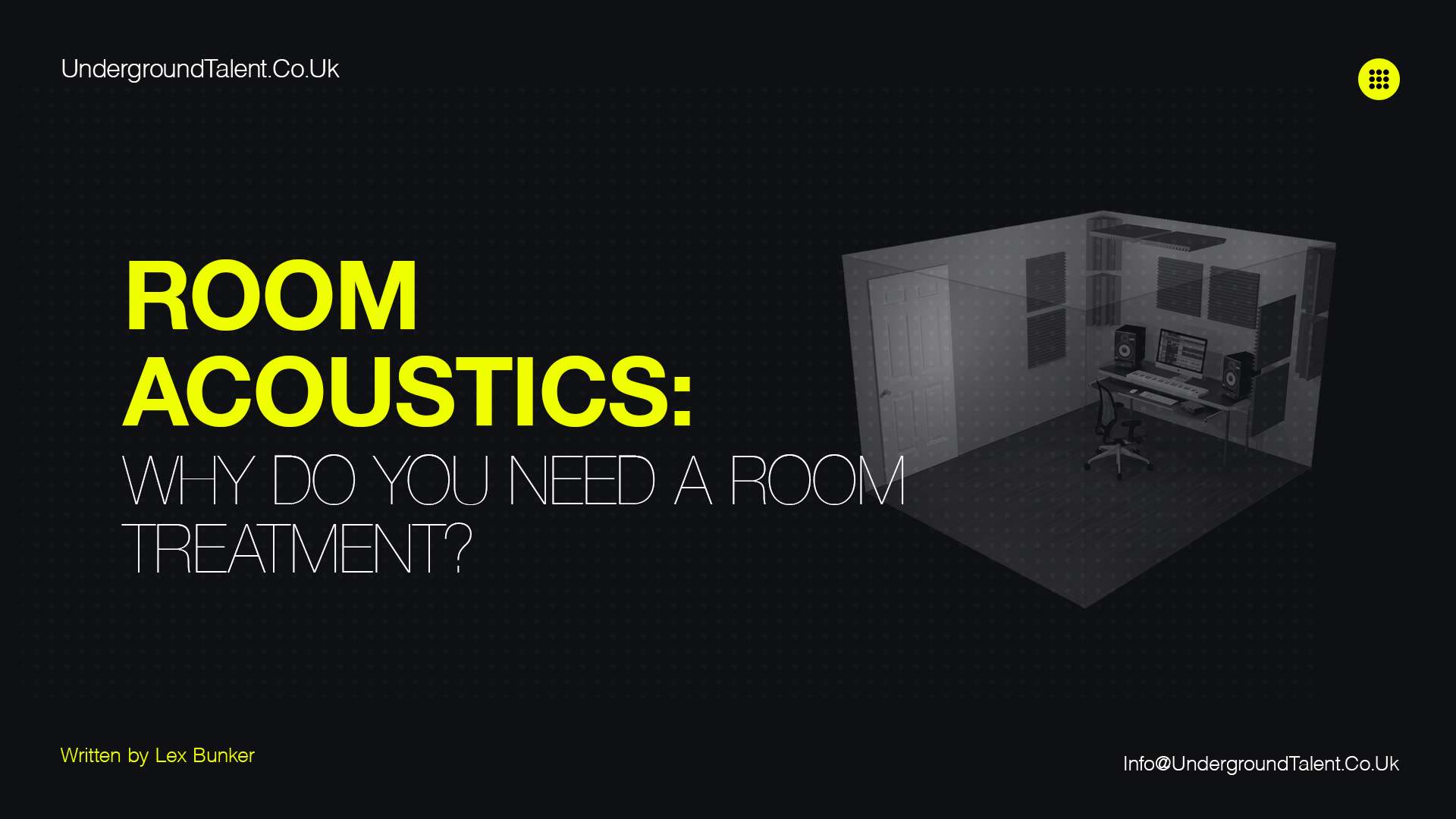Room Acoustics: Why do you need room treatment?
This is the first article of the series. Our aim is to make you learn the importance of room treatment in acoustics and how it can improve sound quality in any space. Discover the benefits of using room treatment to reduce reflections, echoes, and standing waves for a clearer, more balanced sound. Discover this and more in this informative series on Room Acoustics.
Room acoustics is an important consideration for any space where audio is being produced or recorded. The way sound behaves in a room can have a significant impact on the overall sound quality and clarity. Room treatment refers to the process of modifying the acoustic properties of a room to improve its sound quality. This can include a variety of techniques such as adding sound-absorbing materials to the walls, floor, and ceiling, or using bass traps and diffusers to control the reverberation and echo in the room.
Don’t Miss: HZ Multiplier – VST for Free Download + Techno Tutorial
Room Acoustics: Why do you need room treatment? | Reasons
One of the main reasons for room treatment is to control the reverberation time or the amount of time it takes for sound to decay in a room. A room with a high reverberation time will have a longer decay time for sound, which can make it difficult to hear speech or music clearly. This is particularly problematic in spaces that are used for recording or broadcasting, as it can lead to an unclear or “muddy” sound. Room treatment can help to reduce the reverberation time, making it easier to hear speech and music clearly.
Another important reason for room treatment is to control the sound reflections that occur within a room. Sound reflections occur when sound waves hit a surface and are reflected back into the room. These reflections can cause phase interference, which can make it difficult to hear speech or music clearly. Room treatment can help to control these reflections by using sound-absorbing materials or diffusers to scatter the sound waves in different directions. This can help to improve the overall clarity and intelligibility of the sound in the room.
Room treatment is an important consideration for any space where audio is being produced or recorded. It can help to improve the overall sound quality and clarity of the space, making it more suitable for recording, broadcasting, or listening to music. Room treatment can also help to improve the overall acoustics of a space, making it more comfortable and enjoyable to be in.
Don’t Miss: Techno Events: How to Plan & Organize the Perfect Techno Party
Understanding Room Acoustics
Room acoustics play an essential role in determining the sound of your music — be it recording, mixing, or even playing live. Having bad room acoustics can hinder and impair the quality of sound produced, so if you’re looking to take your audio experience to the next level, it’s important to treat your space. Learn why you need room treatment and how it can help improve acoustic performance!
What is Room Acoustics?
Room acoustics refers to the reflection of sound off of surfaces in a room. The amount of reflected sound varies, depending on the type and size of the surface, distance from the source, and proportion of the room. This can affect the quality of sound in a room — if too much sound is being reflected back, it may cause reverberation, echo effects, and other sonic artifacts. Room treatment involves adding acoustic absorbers or diffusers to reduce or modify these reflections for improved acoustic performance.
Room acoustic treatment can dramatically improve the sound quality in any space. By reducing or modifying the room’s reflections, it provides a clearer, more consistent sound image, with improved clarity and less interference from echoes and reverberation. This can be critical for professional audio applications, where accuracy is key, as well as for critical listening environments like home theaters and listening rooms. Room acoustic treatment absorbs unwanted reflections and equalizes the frequency response of a room to deliver a much more accurate sonic experience.
Read Also: 7 Music Industry Tips for Successful Networking
The Impact of Uncontrolled Room Acoustics.
Uncontrolled room acoustics can have a substantial impact on the quality of sound in a room. Too many reflections can result in reverberation, which reduces clarity and detail by masking the original sound source with too much echo and artifacts. Additionally, standing waves can occur due to uneven reflections from two parallel surfaces at different distances away from the source, resulting in certain frequencies being louder than others, and causing resonances or “hot spots” in certain parts of the room. Room treatment helps to mitigate these problems, allowing for clearer sound reproduction and improved listening experience overall.
Room treatment includes the use of acoustic absorbers and diffusers, which work together to affect the frequency response of a room, reduce ambient noise from outside sources, and minimize sound reflections. Acoustic absorbers help to minimize reverberation time and make up for the energy that would otherwise be reflected off walls and ceilings. Diffusers are used to disperse sound in different directions more evenly, making it easier for the listener to pick out individual sounds without any reverberation overpowering them. Room treatment is essential for achieving the best audio quality possible in any given environment, whether it be a home studio or a live performance venue.
Read Also: DJ’s Guide to Local Gigging by Emma Yasumi
Different Types of Room Treatment Techniques and Products.
There are many types of room treatment techniques and products available to address acoustic issues. These include absorptive acoustic panels, diffusive surfaces, bass traps, constrained layer dampening, sound absorbers in the form of acoustic foams and felts, and corner bass absorbers. Additionally, treatments can also be implemented beyond just walls and ceilings – adding physical objects to a space such as furniture can help to absorb reflections too!
Room treatment is critical when it comes to achieving great sound in the studio, and even living room spaces. It can be used to deaden excess reflections, manage bass frequencies, diffuse certain frequencies, and absorb audio energy – even making more precise mixing and mastering possible. Room treatment also helps reduce sound transmission between rooms and makes dialogue recordings more intelligible and natural sounding. With the right setup, it can make all the difference!
Read Also: Stop Being a Perfectionist by Lex Bunker
Assessing Your Current Room and Identifying Problem Areas.
Identifying problem areas in your space is key to improving acoustic performance. The best way to start is by walking around the space and assessing your current acoustics. Listen for any echoes, reverberations, or frequency issues such as muffled bass frequencies or overly “bright” highs. Additionally, you may want to identify any source of exterior noise that can enter the room (such as traffic outside). Addressing these areas with appropriate treatment solutions should help achieve better overall sound quality.
But why stop there? Moving around the room and actually listening to a variety of sources (such as music, movies, or spoken word) can help you identify other problem areas within the space. You should feel comfortable at all points in the room so that you can get the most out of your sound system. As such, isolating any issues with subpar acoustics is key for ensuring that everyone in the room experiences adequate sound quality during every type of listening session. Room treatment solutions–backed by acoustic measurements–are needed to create an optimal listening environment, both aesthetically and sonically.
Don’t Miss: House Music – An In-depth Guide to Music Production
Putting Together an Effective Room Treatment Strategy.
Constructing a room treatment plan goes beyond just adding sound-absorbing materials. It’s important to consider the size of your space, budget, and other environmental factors such as background noise and reflections that can affect the acoustic performance. There are many ways to improve the acoustics in any room from building DIY acoustic solutions to investing in professional-grade acoustic treatments. Taking the steps necessary to properly treat a room will help ensure improved sound quality for your recording or listening sessions.
Comprehending the basics of acoustic theory is necessary for formulating an effective room treatment strategy. Room modes, reflections, and background noise are common problems that can significantly reduce sound quality. In order to address these issues adequately it’s important to know what causes them and how they interact with one another. As for the solutions, bass traps are often used to absorb low frequencies below 400 Hz as well as help combat reflections from room corners. Other materials such as diffusers help disperse sound waves evenly across space and can be used in combination with absorbers. With a detailed plan and proper implementation, it’s possible to get superior acoustic performance out of any space regardless of its size and shape.
Don’t Miss: Fossil Archive aka Roberto / R.M.K. @ Special Guest Interview
Conclusion
In conclusion, room treatment is an essential aspect of achieving good sound quality in any room. Without proper treatment, the sound in a room can be affected by reflections, echoes, and standing waves, which can lead to muddy, unclear, or uneven sound.
Room treatment can help to absorb or diffuse these unwanted sound reflections, resulting in a clearer, more balanced sound. Additionally, room treatment can also help to reduce noise and improve the overall acoustics of a space.
Whether you’re a musician, a home theater enthusiast, or a business owner, investing in room treatment can make a significant difference in the quality of sound in your space. It’s important to understand the basics of room acoustics and how to apply that knowledge in treating the room for better sound quality.
Don’t miss the next article in this informative series on Room Acoustics: Understanding Sound Waves and Reflections. Learn how sound waves and reflections affect the acoustics of a room and how you can use this knowledge to improve the sound quality in your space. Click here to read the next article and take the first step towards achieving the perfect sound.
You can find us on Facebook, Soundcloud, and Instagram, and don’t hesitate to reach out to us if you have any questions or comments by email on info@undergroundtalent.co.uk.
Don’t miss out on the latest and greatest underground talent! Subscribe to our YouTube channel now and stay on top of the freshest and most exciting new acts in the techno scene. Click the subscribe button and join our community of techno music lovers today!
Read Also: How to Promote Electronic Music | 10 Ways For Beginners
And Always Remember…
Have Fun & Be Creative!





